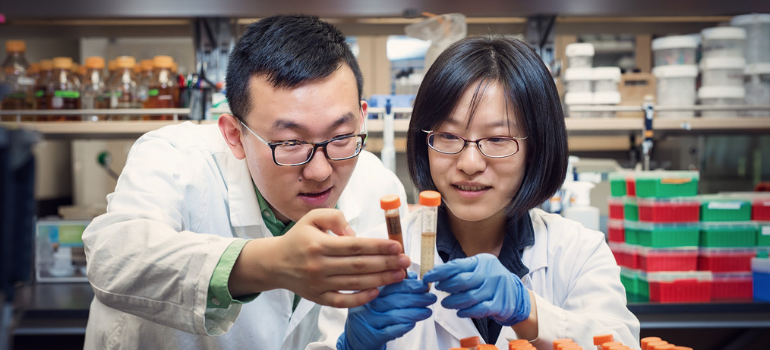AN EFFICIENT way to quantify the levels of antioxidants in chocolate during its manufacture (from raw cocoa beans to chocolate bars) has been developed by food scientists at the University of British Columbia.
While it may not be a substitute for the current method, the new technique which uses infrared spectroscopy shows very reliable results, the scientists said. In contrast, the traditional one relies on biochemical tests to read absorbance values and can be quite time consuming and expensive.
“Our method predicts the antioxidant levels in chocolate in under a minute, compared to the industry standard that can take several hours or even days,” said Xiaonan Lu, an assistant professor in food, nutrition and health in the faculty of land and food systems, who developed the method alongside PhD student Yaxi Hu. “It’s not a substitute for the traditional method used at the moment, but it does show a strong correlation for being just as reliable.”

UBC’s Xiaonan Lu and Yaxi Hu are testing antioxidant levels in raw cocoa beans to chocolate bars. (Photo: Martin Dee)
Infrared spectroscopy is used to illuminate infrared light onto chocolate samples. The infrared spectra record the chemical composition of each sample, including the amount of polyphenols, micronutrients with high antioxidant properties.
“Testing for antioxidant levels can give chocolatiers guidance on which cocoa beans to select, or how to improve their processing parameters,” said Hu.
Chocolate is made from cocoa beans and is manufactured through several processing stages, including drying, roasting and fermentation of the beans. The UBC food scientists have started to use their method to measure cocoa bean samples from around the world in each stage to determine when antioxidant levels are at their highest and lowest.
“If we identify drying as the step that significantly lowers the bean’s antioxidant properties, for example, we will want to develop a strategy to reduce the drying time, or drying temperature,” Lu said.
It could be considered incredibly valuable information for chocolate companies who want to make products high in antioxidants or appeal more to health-conscious consumers.
Antioxidants benefit human health and help contribute to the prevention of cancers, vision loss and heart diseases. Antioxidant compounds are commonly found in foods like pecans, blueberries and chocolate.
Lu and Hu’s research on cocoa beans is in its early stages as they test hundreds of samples. The method they developed to test for antioxidant levels was funded by a local chocolatier in Metro Vancouver, the Natural Sciences and Engineering Research Council (NSERC) and by the non-profit MITACS.
Nike Air Presto Fly













